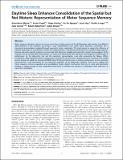Daytime Sleep Enhances Consolidation of the Spatial but Not Motoric Representation of Motor Sequence Memory

View/
Author
Albouy, Geneviève
Fogel, Stuart
Pottiez, Hugo
Nguyen, Vo An
Ray, Laura
Lungu, Ovidiu
Carrier, Julie
Doyon, Julien
Published Version
https://doi.org/10.1371/journal.pone.0052805Metadata
Show full item recordCitation
Albouy, Geneviève, Stuart Fogel, Hugo Pottiez, Vo An Nguyen, Laura Ray, Ovidiu Lungu, Julie Carrier, Edwin Malcolm Robertson, and Julien Doyon. 2013. Daytime sleep enhances consolidation of the spatial but not motoric representation of motor sequence memory. PLoS ONE 8(1): e52805.Abstract
Motor sequence learning is known to rely on more than a single process. As the skill develops with practice, two different representations of the sequence are formed: a goal representation built under spatial allocentric coordinates and a movement representation mediated through egocentric motor coordinates. This study aimed to explore the influence of daytime sleep (nap) on consolidation of these two representations. Through the manipulation of an explicit finger sequence learning task and a transfer protocol, we show that both allocentric (spatial) and egocentric (motor) representations of the sequence can be isolated after initial training. Our results also demonstrate that nap favors the emergence of offline gains in performance for the allocentric, but not the egocentric representation, even after accounting for fatigue effects. Furthermore, sleep-dependent gains in performance observed for the allocentric representation are correlated with spindle density during non-rapid eye movement (NREM) sleep of the post-training nap. In contrast, performance on the egocentric representation is only maintained, but not improved, regardless of the sleep/wake condition. These results suggest that motor sequence memory acquisition and consolidation involve distinct mechanisms that rely on sleep (and specifically, spindle) or simple passage of time, depending respectively on whether the sequence is performed under allocentric or egocentric coordinates.Other Sources
http://www.ncbi.nlm.nih.gov/pmc/articles/PMC3534707/pdf/Terms of Use
This article is made available under the terms and conditions applicable to Other Posted Material, as set forth at http://nrs.harvard.edu/urn-3:HUL.InstRepos:dash.current.terms-of-use#LAACitable link to this page
http://nrs.harvard.edu/urn-3:HUL.InstRepos:10612896
Collections
- HMS Scholarly Articles [17922]
Contact administrator regarding this item (to report mistakes or request changes)


